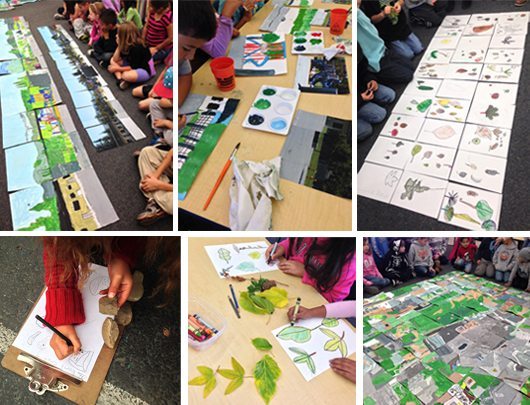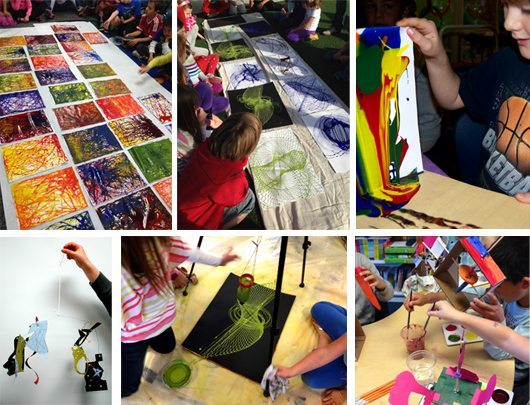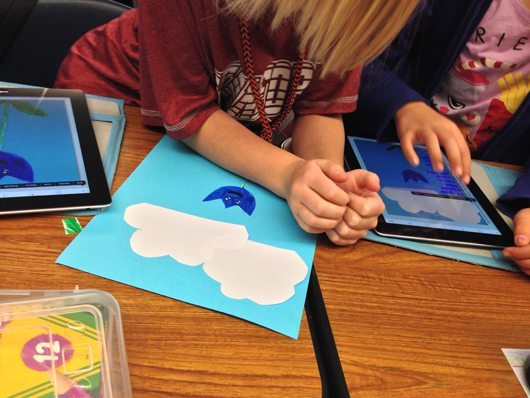Location: San Francisco Bay Area (Sunnyvale, Campbell, Sausalito), CA, U.S.A.
 INTRODUCTION
INTRODUCTION
AS AN ARTIST/EDUCATOR1 WORKING with the new common core standard recently implemented in the U.S., I think it only makes sense to integrate the arts into the learning of each aspect of school curriculum. Science is my subject of choice, with a specific interest in water.
I was raised in a family of scientists (researchers and teachers) and I developed a deep love and respect for science. My father (a geologist) appreciated a beautiful landscape, but I was fascinated by the way he could ‘read’ a landscape: he could tell me the way it looked million years ago, and the transformations still at play in the present time. He could always determine the location of a natural spring by studying the structure of a landscape. My mother (a biologist) always gave my sister and me many interesting details about the plants and animals encountered during our numerous hikes.
My goal while teaching is to make the best use of the resources in our immediate environment and create a journey for the students in which they become enthusiastic artist-scientists, connecting with nature by observation of its infinite diversity. By taking a new look at the environment, we see the mundane become extraordinary.
Engaged students are excited about making art, are open to new ideas, and trust their own thinking. Activities are personalized for each student: they can use a rock or any other finding; they can use a photo of the unique landscape they are working on. The more they look, the more they see, and the more they can open their minds, think freely, and get new ideas. This makes the experience unique for each student. Each exercise is anchored in their reality, their everyday life. I like to make them think about the fact that any place, and any element provided by nature, is unique so that the journey becomes a source of surprises. This personalization helps the students understand the complex world they live in.
The holistic aspect of the common core is for me very exciting because it is the way I see my own practice: everything is interconnected. The goals are clear, but each student follows a personal path at a personal pace. I am careful that the exercises are not too technically driven. Working with Charlee Wagner, Director of the Teaching Artists Program at Montalvo Arts Center2, and Dana Cilmi, Director of the Artists Teaching Art Program at the Sausalito Art Festival Foundation3, I have had the opportunity to teach workshops that encourage invention, experimentation, and problem solving. Both programs are STEM-to-STEAM4 initiatives taking place in elementary schools. My goal in these workshops is for the students to learn in a playful and creative way. I put an emphasis on comprehending art processes.
I. ROCKS AND SOIL
2nd Graders, Montalvo Arts Center, Campbell, CA, 2013
THE ROCKS AND SOIL UNIT5 is part of the Earth Sciences 2nd grade curriculum. The students start by observing the landscape around the school and elements of nature found on the school grounds: rocks, leaves, twigs, eventual fruits, cones, flowers. The idea is that the school is a world worth discovering, and there are things we can use to start a journey toward understanding where rocks come from, how the soil is formed and how natural resources are used—almost all the things necessary to build a school come from underground.
During a 1-hour session each week, for 10 weeks, the emphasis is on observation skills, and the students learn to draw and paint what they see. They are naturalists trying to be as precise as possible in their observations. Nature offers an infinite variety of forms, shapes, colors, and patterns that can be studied using different techniques.
At the end of each session, the students engage in a group discussion. Seeing what everyone did is an important part of the project, and always welcomed by the students. Positive critique empowers them to express their ideas about their own work and those of others. Discussions comprise both science and art aspects of the exercise.
II. FORCES AND MOTION
2nd Graders, Montalvo Arts Center, Campbell, CA, 2014
FORCES AND MOTION6 IS PART of the Physical Sciences 2nd grade curriculum. The integration of art into Forces and Motion provided the opportunity to work with the students on a variety of exercises, from 2D to 3D, all involving different forces: push, pull, gravity, friction—and sometimes all of them at the same time. The exciting thing about some of the exercises is how they reveal the forces: the kids can ‘see’ them in action before their eyes during the process, for example, of creating patterns with paint or ink.
None of the exercises involved the use of traditional tools. For blow-painting the students used straws and pipettes. For ball-painting they used plastic balls and marbles. For pendulum-painting they used plastic bottles filled with paint suspended from a tripod. And for gravity-painting, the only tool used was gravity itself.
For the 3D exercises—the mobile and the automaton—the students used all sorts of materials including bamboo skewers, foamies, cardboard, twist ties, and fabric.
The students worked in teams when they did the ball-painting and the pendulum-painting. One student made the painting while another documented the process with an iPad, and then they traded places. Documenting the process was an excellent way to see the forces at play during an exercise.
At the beginning of the sessions, we watched short videos (Holton Rower, Jackson Pollock, Alexander Calder, the Automata museum in Glasgow), all related to the exercises we were going to work on. We took time for some positive discussions about what was made by the class—a time to watch, think, reflect, and give feedback to the group. During each session there was time for experimentation.
One defining moment was when I asked the students to ‘undo’ their mobiles and try another solution for the balance of the elements, like an artist might do when going back to the studio after working on a piece for a short time. The idea to work again on something they thought was pretty much done was tough for the majority of them. But by the end of the session, when asked, most of the students said that although it was a hard thing to do, they preferred the second version of their mobile.
The ten sessions went by fast! Through these exercises my hope was that the students were able to understand that forces in motion are everywhere, how to recognize them, and how they can play a major role in the process of making art.
III. WHAT A WONDERFUL CREEK
3rd Graders, Sausalito Art Festival Foundation (SAFF), Sausalito, CA, 2013
THE SAUSALITO ART FESTIVAL FOUNDATION strongly encourages the integration of the arts into the elementary school curriculum. For ‘What a Wonderful Creek’7 in which technology is a key component, the third grade students made a video. Students from Willow Creek Elementary School engaged the community (collaboration, interview, and documentation of the process) through science, language arts, and history. The reclamation project focused on a small creek next to their school and covered the history of the creek, beginning with the Ohlone people. I worked with students from two different classes, rotating small groups. Each group had a videographer, one person responsible for the sound, someone documenting the process with a digital camera, and an interviewer. The experience was very empowering for the students, who felt responsible for the material and were careful to handle it correctly.
Other visual artists were working on the project as well, making collage panels with the children about the history of the creek. Everything was coordinated by two fantastic elementary school teachers.
Before going into the field, we talked about the footage we needed: landscapes, groups of students working (weeding, planting), plants, animals, and we talked about the interviews they were to conduct. We took some time to talk about light, framing, and sound.
Going to the creek together was a great experience. I enjoyed the energy of the students; they were all very excited about the reclamation project and the video project. The crews were focused. We recorded some original music made by the students in the music class. We also recorded the song, ‘What a Wonderful Creek!’ outside, with a nice lush and natural background.
The students took and watched lots of footage. They then selected the clips they found most interesting. Some clips were interesting for the sound, some clips for the images, and some clips for both. The students edited the video in Adobe Premiere professional editing software, using only a few functions.
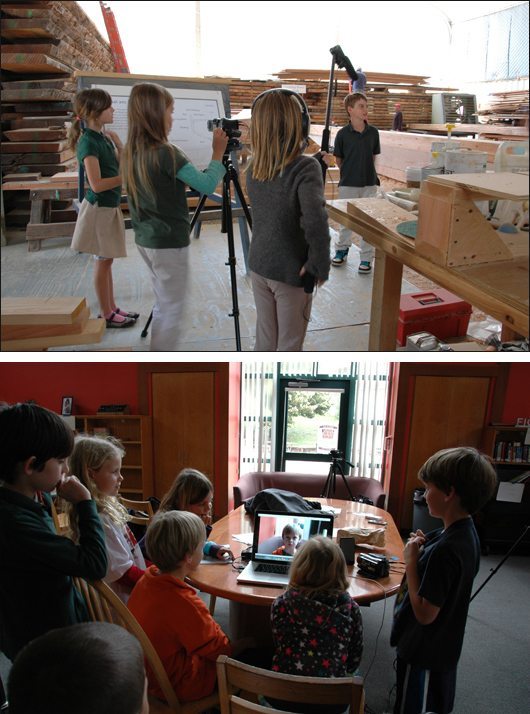
IV. SAILING THROUGH SAUSALITO HISTORY Graders, Sausalito Art Festival Foundation (SAFF), Sausalito, CA, 2013-2014
SAILING THROUGH SAUSALITO HISTORY8 was a year-long project with Willow Creek Elementary. In this project the students studied the maritime history of the San Francisco Bay through five important ships, starting with the Ohlone People and their tule boat. The students had a great opportunity to visit the construction site of a tall ship being built right now in Sausalito. What the students learned touches on all the aspects of the curriculum: sciences, mathematics, and language arts. The arts integration was conducted by different artists. I was responsible for the video, teaching the students how to storyboard, film, and edit. The video comprises interviews and stories about the different ships. All the children were involved, taking turns and sharing the material.
V. WATER CONSERVATION AWARENESS POSTERS
4th and 5th Graders, Sunnyvale, CA
THIS PROJECT TOOK PLACE AT my son’s elementary school, where I have volunteered as an art teacher since my family moved to the Bay Area. The 4th/5th grade teacher, Ms. Faure, is a science and art lover, and we decided to work together on a special project centered around water conservation, in the context of the severe drought California is going through. The project started with a great class presentation by Jacqueline Davison, Outreach Coordinator in the Sunnyvale Environmental Services Department. The students learned that the water that flows into storm drains goes untreated straight into creeks and through them travels to the bay. The 4th and 5th grade combo-class also visited the Water Pollution Control Plant in Sunnyvale, where the students learned how the water is cleaned after it is used at home and school, and in offices, stores, and restaurants.
The question for the students was: How can you communicate to the people around you that there are lots of things we could and should do to conserve water and use it better at home, in our backyards, and elsewhere? The students decided to make a series of posters. They worked in small groups, each group focusing on one particular issue. They used the iPads available in their classroom with an app we downloaded called PosterMaker.
The students focused on one or two messages per group. They searched for photos on the Internet, drawing and creating composite images. They worked images and messages together. The flexibility of PosterMaker enabled the students to try many combinations and to store different versions of their posters in an iPad photo album. They had to decide the size of each element and how to solve problems of contrast between words and images. They finally chose a final version of the poster to share with the community. It took several sessions (of approximately one hour each) to make the posters.
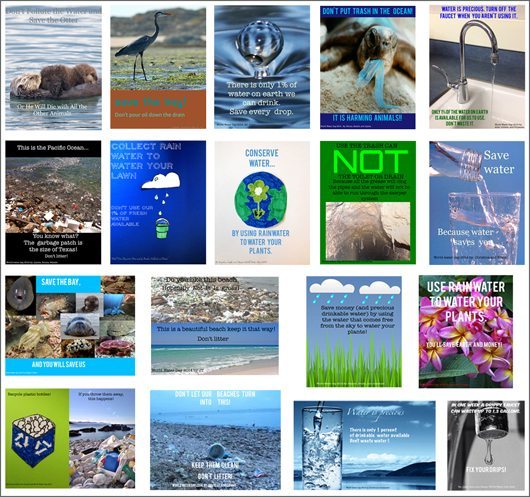
VI. BAY AREA WATERSCAPES
4th and 5th Graders, Sunnyvale, CA
STUDYING THE REGION IS PART OF the 4th/5th grade curriculum. With this project I asked the students to take a closer look at some of the different landscapes that the larger Bay Area offers. The students took the time to study the photos I provided. Each student worked with a different photo. They first drew with simple lines the main features of these special places and then added color with watercolor inks and black oil pastels. The technique is very rewarding—the fact that there were no two identical photos created a very diverse series as there is no possible comparison between the images (and therefore no frustration). We displayed the series on the floor and discussed and reflected on the importance of the landscapes and, more specifically, the role water plays in them.
VII. WATERWHEEL WORLD WATER DAY SYMPOSIUM, MARCH 2014
4th and 5th Graders, Sunnyvale, CA
IN MARCH 2014, THE STUDENTS had the opportunity to present their work during the Waterwheel World Water Day Symposium, an online international event where artists and scientists share their work about water. 2014 is the first year with a ‘Voices of the Future’ section open to youth. Children are welcome to submit their projects and ideas about water. The students made their presentation from their classroom in Sunnyvale via an online platform in real time. They first presented their water conservation awareness posters and then their Bay Area waterscapes9. Students were free to talk in front of the camera. Some decided not to, but they were all very involved in the process. It was quite an organization due to the schedule of the symposium. The presentation went very well, and the children were excited to participate and have their voices heard.
CONCLUSION
I first started working with elementary school students many years ago—when my children entered school, I volunteered every year in their classes as an art teacher. Progressively over time the series of exercises I created became associated with the curriculum. Today I am very grateful and excited to work with two art foundations dedicated to ensuring that art education is provided in elementary schools and to inspiring students to think ‘outside the box.’ My desire is to integrate art across the curriculum to help students better understand real-world problems and to envision a teaching process in which everything is interconnected.
END NOTES
All photos by Michele Guieu.
1 See Michele Guieu’s work at:https://directory.weadartists.org/artist/michele-guieu and her website :http://www.micheleguieu.com/wordpress/
2 Teaching Artists Program, Montalvo Arts Center: http://montalvoarts.org/programs/teaching_artists.
3 Artists Teaching Art, Sausalito Art Festival Foundation: http://sausalitoartfestival.org/artists-teaching-art
4 With the addition of ‘Art,’ STEM (Science, Technology, Engineering, and Math) initiatives become STEAM initiatives.
5 For more about the Rocks and Soil unit, see http://www.micheleguieu.com/wordpress/inspiration/?p=5340
6 For more about the Forces and Motion unit, see http://www.micheleguieu.com/wordpress/inspiration/?p=5553
7 For more about What a Wonderful Creek, seehttps://vimeo.com/71587342
8 For more about Sailing through Sausalito History, seehttps://vimeo.com/98568511
9 For more about Bay Area Waterscapes, Part I see:http://www.micheleguieu.com/wordpress/inspiration/?p=5292. For more about Bay Area Waterscapes, Part II:http://www.micheleguieu.com/wordpress/inspiration/?p=5813

